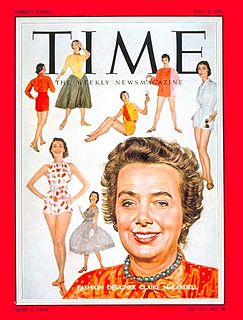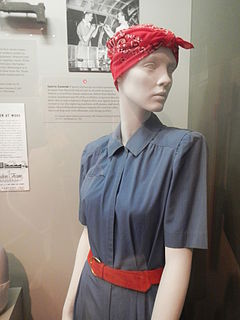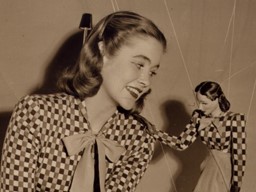
Anne Elisabeth Jane Claiborne was an American fashion designer and businesswoman. Her success was built upon stylish yet affordable apparel for career women featuring colorfully tailored separates that could be mixed and matched. Claiborne is best known for co-founding Liz Claiborne Inc., which in 1986 became the first company founded by a woman to make the Fortune 500 list. Claiborne was the first woman to become chair and CEO of a Fortune 500 company.

James Galanos was an American fashion designer and couturier.

Claire McCardell was an American fashion designer of ready-to-wear clothing in the twentieth century. She is credited with the creation of American sportswear.
Anne Klein was an American fashion designer and businesswoman, the founder and namesake of Anne Klein & Company.

History of fashion design refers specifically to the development of the purpose and intention behind garments, shoes and accessories, and their design and construction. The modern industry, based around firms or fashion houses run by individual designers, started in the 19th century with Charles Frederick Worth who, beginning in 1858, was the first designer to have his label sewn into the garments he created.
Bonnie Cashin was an American designer, she is considered to be one of the pioneering designers of American sportswear. She created practical, uncomplicated clothing that catered to modern, independent woman of the post-war era through to her retirement from the fashion world in 1985. E

Vera Huppe Maxwell was a pioneering sportswear and fashion designer.

Elizabeth Hawes was an American clothing designer, outspoken critic of the fashion industry, and champion of ready to wear and people's right to have the clothes they desired, rather than the clothes dictated to be fashionable, an idea encapsulated in her book Fashion Is Spinach, published in 1938. She was among the first Americans to establish their reputations outside of Paris haute couture. In addition to her work in the fashion industry as a sketcher, copyist, stylist, and journalist, and designer, she was an author, union organizer, champion of gender equality, and political activist.
Muriel King (1900–1977) was an American fashion designer based in New York City. She was one of the first American fashion designers along with Elizabeth Hawes and Clare Potter to achieve name recognition. She also designed costumes for several major films in the 1930s and 1940s.

Sportswear is an American fashion term originally used to describe separates, but which since the 1930s has come to be applied to day and evening fashions of varying degrees of formality that demonstrate a specific relaxed approach to their design, while remaining appropriate for a wide range of social occasions. The term is not necessarily synonymous with activewear, clothing designed specifically for participants in sporting pursuits. Although sports clothing was available from European haute couture houses and "sporty" garments were increasingly worn as everyday or informal wear, the early American sportswear designers were associated with ready-to-wear manufacturers. While most fashions in America in the early 20th century were directly copied from, or influenced heavily by Paris, American sportswear became a home-grown exception to this rule, and could be described as the American Look. Sportswear was designed to be easy to look after, with accessible fastenings that enabled a modern emancipated woman to dress herself without a maid's assistance.

Anne Fogarty was an American fashion designer, active 1940–80, who was noted for her understated, ladylike designs that were accessible to American women on a limited income. She started out as a model in New York in 1939, working for Harvey Berin on Seventh Avenue, before studying fashion design. She eventually secured a full-time design job in 1948, and became well-known for full-skirted designs with fitted bodices, inspired by Dior's New Look.

Francesca Sterlacci is an American fashion designer, author and entrepreneur. She launched her clothing brand, Francesca Sterlacci Ltd. in 1980, and continued designing clothes under her label until 1989. Sterlacci joined the Fashion Institute of Technology as a teacher in 1990, and became the chairwoman of the Fashion department at the institute in 2001.

Alexander "Omar" Kiam was an American fashion designer and costume designer.

A bumper brim is a millinery feature in which the hat brim is tubular in design, making it a prominent feature of the hat. In order to achieve this effect, the brim may be rolled, stiffened or padded. A bumper brim can be added to a variety of hat designs, from small to large.
Adolfo Sardiña, professionally known as Adolfo, is a Cuban-born American fashion designer who started out as a milliner in the 1950s. While chief designer for the wholesale milliners Emme, he won the Coty Award and the Neiman Marcus Fashion Award. In 1963 he set up his own salon in New York, firstly as a milliner, and then focusing on clothing. He retired from fashion design in 1993.

Thomas Franklin Brigance, professionally known as Tom Brigance, was a Texan-born New York-based fashion designer noted for his work in sportswear in the 1930s, 1940s and 1950s. As a house designer for Lord & Taylor, Brigance was best known for bathing costumes and play clothes, and for his clever use of flattering details such as pleats and darts. During the 1930s Brigance was a rare example of a male working in the female-dominated world of American sportswear design. In the late 1930s, he was regularly mentioned alongside Clare Potter as a leading name in mid-range priced sportswear. Like Potter, Brigance was skilled at designing smart, fashionable clothing which could easily be mass-produced, making his work attractive to manufacturers as well as to customers.

Emily Wilkens (1917-2000) was an American fashion designer specialising in childrenswear. She won both the Neiman Marcus Fashion Award and the Coty Award for her work, which was considered groundbreaking for properly taking note of the requirements of teenage dressing, and not simply offering miniature grown-up garments. She was also an author, writing a number of books on self care and style, and during the late 1960s and early 1970s, became a beauty journalist, writing an advice column. She died in 2000.
Tina Leser was an American fashion designer. Part of a generation of pioneering sportswear designers, Leser was particularly known for her global influences.
Carolyn Schnurer was a fashion designer and a pioneer in American sportswear. Schnurer's designs have been featured in the magazines Vogue, Harper's Bazaar, and Life as well as in the Metropolitan Museum of Art. She has also received awards for her designs from Coty, The Cotton Council, International Sportswear, Miami Sportswear, and Boston Sportswear.

Sally Milgrim was an American businesswoman and fashion designer. She notably designed the dress Eleanor Roosevelt wore to her husband's first inaugural ball.















